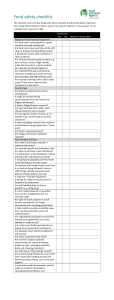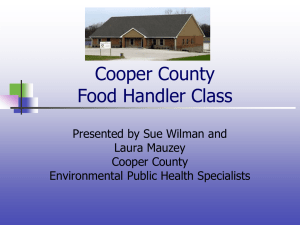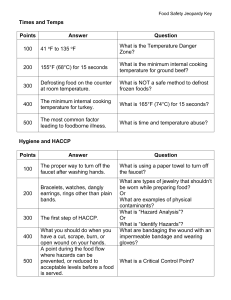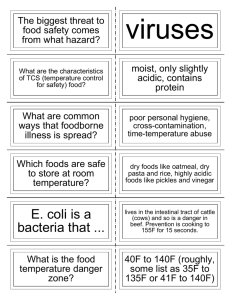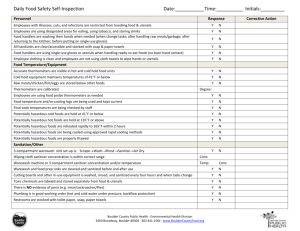Food Safety Orientation Training
advertisement
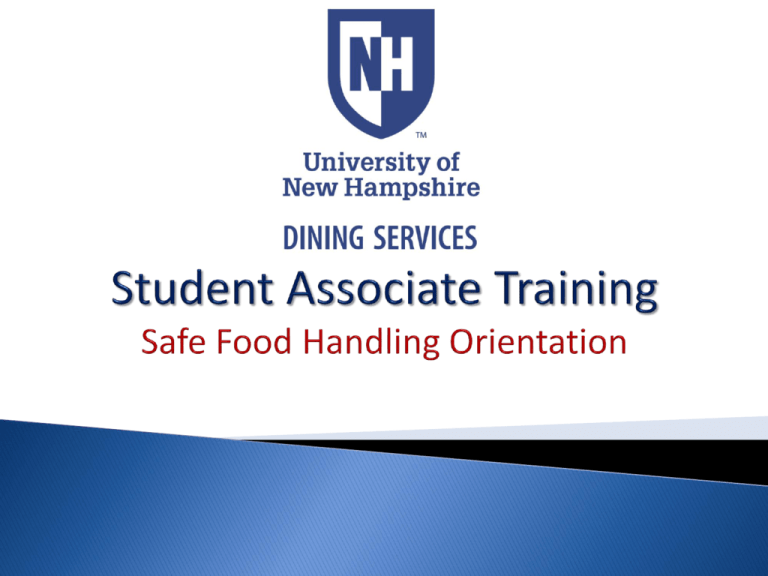
Your role as a Student Associate working with UNH Dining Services is to assist the full time associates in providing a safe, clean, and enjoyable campus dining experience to our guests. To help you accomplish these goals this department has created this on-line Safe Food Handling Orientation so that you may become familiar with and successfully practice the basic concepts involved in providing safe food and clean facilities to the guests we serve. Thank you for choosing to work with UNH Dining Services. Food Safety is a scientific discipline describing preparation, storage, and handling of food in ways that prevent food borne illness Food Borne Illness is an illness carried or transmitted to people by food You will be working in a position that has the potential to make many people sick; possibly even causing them to suffer from serious medical complications that require them to seek medical care if you do not follow some basic Food Safety rules. Time Temperature Abuse is what happens when Potentially Hazardous Foods are left in the Temperature Danger Zone for too long. A Potentially Hazardous Food is any food that will support the growth of harmful microbiological organisms. Food items high in protein such as meats, soy products, and dairy items are usually considered potentially hazardous foods and need special handling care. The Temperature Danger Zone is the temperature range in which harmful microbiological organisms grow / reproduce most rapidly. Above 135 F 135 F Temp. Danger Zone 41 F Below 41 F Biological Chemical Physical Biological hazards include: Viruses Bacteria Parasites Fungi Chemical Hazards include: Cleaners Sanitizers Polishes Machine lubricants Toxic metals Physical Hazards include: Hair Dirt Bandages Metal staples Broken glass Natural objects (e.g., fish bones in a fillet) Time-temperature abuse Cross-contamination Poor personal hygiene These are the three critical factors that contribute to unsafe food and they are preventable. Food has been time-temperature abused when: It has remained too long in the Temperature Danger Zone. The Temperature Danger Zone is the temperature range in which pathogens (bad microbiological organisms) grow and reproduce most rapidly. This temperature range has been identified as 41 degrees (F) to 135 degrees (F). It is important to keep foods that can support pathogenic growth out of this temperature range. Above 135 F 135 F Temp. Danger Zone 41 F Below 41 F Cross-contamination occurs when: Physical, chemical, or biological hazards are transferred from one food or surface to another. Poor personal hygiene occurs when food handlers: Don’t wash their hands right after using the restroom Come to work while sick Cough or sneeze on food Touch or scratch infected wounds and not wash their hands Food handlers can contaminate food when they: Have a food borne illness and handle food Have open wounds that contain a pathogen Have contact with a person who is ill Touch anything that may contaminate their hands and don’t wash them Have symptoms such as diarrhea, vomiting, or jaundice—a yellowing of the eyes or skin A. Scratching the scalp B. Running fingers through hair C. Wiping or touching the nose D. Rubbing an ear E. Touching a pimple or infected wound F. Wearing a dirty uniform G. Coughing or sneezing into the hand H. Spitting in the operation Three simple ways that you can practice Safe Food Handling while working here at UNH Dining Services are: Prevent Time Temperature Abuse Prevent Cross Contamination Practice Good Personal Hygiene Avoid time-temperature abuse Keep food out of the temperature danger zone. Keep Hot Foods Hot and Cold Foods Cold Make sure your work area has a thermometer that is appropriate for taking food temperatures. Regularly record temperatures of hot and cold foods and record each time the temperature is taken. Take corrective actions if timetemperature standards are not met. Above 135 F 135 F Temp. Danger Zone 41 F Below 41 F Separate Equipment Use separate equipment for different types of food Cooked Foods vs. Raw Foods Meats vs. vegetables Prepare food at different times Prepare raw meat, seafood, and poultry at different times than ready-to-eat food (when using the same prep table) Clean and Sanitize Clean and sanitize all work surfaces, equipment, and utensils after each task Good personal hygiene includes: Maintaining personal cleanliness Wearing proper work attire Following hygienic hand practices Avoiding unsanitary habits and actions Maintaining good health Reporting illnesses Wash regularly No offending odors and no strong perfumes or cologne Keep finger nails trim, neat, and clean No dirt, grease, or oils under your nails or on hands No fake finger nails Food handlers should: Wear a clean hat or other hair restraint Wear clean clothing daily Remove aprons when leaving foodpreparation areas Remove jewelry from hands and arms when working with food or when working around preparation areas How to Wash Your Hands Properly: Single-use gloves used for handling food: Must never be used in place of hand washing Must never be washed and reused Must fit properly When to change gloves: As soon as they become soiled or torn Before beginning a different task After handling raw meat, seafood, or poultry and before handling ready-to-eat food Foodhandlers must not: Eat, drink, smoke, or chew gum or tobacco while working. When: Preparing or serving food Working in food preparation areas Working in areas used to clean utensils and equipment All food must have a label that includes: Name of the food Date by which it should be sold, eaten, or thrown out Discard food that has passed the manufacturer’s expiration date. Ready-to-eat food that was prepared in-house: Can be stored for 7 days at 41°F (5°C) or lower Must be thrown out after 7 days Rotate food to use the oldest inventory first. Identify the food item’s use-by or expiration date Store items with the earliest use-by or expiration dates in front of items with later dates Use items stored in front first Store food items in the following top-to-bottom order: Ready-to-eat food Seafood Whole cuts of beef and pork Ground meat and ground fish Whole and ground poultry Above 135 F 135 F Temp. Danger Zone 41 F Below 41 F Cook hot foods to their appropriate internal temperature All hot foods must be held at or above 135 degrees F. When cooking in a microwave all food must be 165 degrees F. Cool down food quickly. Put in shallow pans. Use the ice wands or ice paddles. Leave uncovered in the FREEZER. Check and record the temperature often. Leave loosely covered in cooler overnight. Food must be cooled to 70 degrees in 2 hours and to 41 degrees or below in an additional 4 hours. Remember to date and label the food. Food Reheated for Service or Hot-Holding Must be reheated to an internal temperature of 165°F (74°C) for 15 seconds within 2 hours To prevent contamination when serving food: Handle ready-to-eat food with tongs, deli sheets, or gloves Use clean and sanitized utensils for serving Use separate utensils for each food Clean and sanitize utensils after each task Store serving utensils correctly between uses On a clean and sanitized food-contact surface In the food with the handle extended above the container rim Guidelines Clean the machine as often as needed Scrape, rinse, or soak items before washing Use the correct rack for the items being washed Check racks for soiled dishes as they come out of the machine Air-dry all items Check the machine’s water temperature and pressure Temperatures may vary depending upon equipment. Questions? If you have questions, please ask your supervisor or contact: Eric Gibson Assistant Manager Stillings Hall 862-1375 Test Time! Click Here to Access the Food Safety Orientation Test. Print out the test/certification form. Take the test. Sign the form. Hand it in to your Supervisor. They will keep it on file. Either your Supervisor or I will contact you if there is a problem with your test.
